Grade Level
6 - 8
minutes
45 to 90 minutes
subject
Life Science, Engineering and Tech
stem practices
Developing and Using Models, Asking Questions and Defining Problems
Activity Type:
Engineering design challenge, STEAM, Family activity, After School Activity
Take a look at the picture below. It shows an astronaut wearing a harness while using a treadmill on the International Space Station. Why do you think she needs that harness?
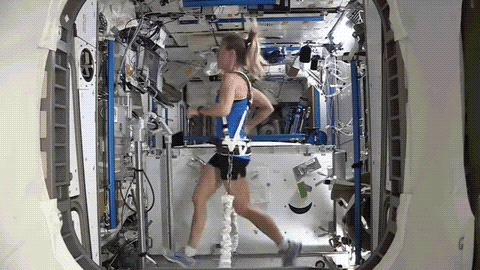
Without gravity, many typical exercises simply don’t work in space. The ISS gym has a treadmill (the T2 COLBERT) and stationary bike (the Cycle Ergometer with Vibration Isolation System, or CEVIS) adapted to zero-gravity use, with harnesses and bungees to keep astronauts from floating away while they exercise. Astronauts also rely on the ARED, the Advanced Resistive Exercise Device. The machine uses vacuum cylinders to create resistance on a bar, simulating free weights on Earth, allowing astronauts to do squats, bench presses, dead lifts, and more to exercise their entire body. Astronauts follow an intense exercise routine to keep their bodies healthy in space.
Down To Earth: Space Science For Community Change
Exercise Like An Astronaut
You may be on Earth, but you can still exercise like an astronaut to improve your muscle strength and heart health. Here are some moves you can try anywhere.
- Warm up your muscles and get the heart pumping: Warming up your muscles before a workout improves your flexibility, increases blood flow, and aids your body’s ability to get oxygen and nutrients to your muscles. As a result you’ll have less risk of injury or stress on your heart, making exercise more effective.
– Jog in place for 15 to 30 seconds: Keep your back straight and shoulders relaxed. Focus your eyes forward. Swing your opposite arm and leg. Try to land on the ball of your foot rather than your heel. Take light steps.
– Seated adaptation: Try some jumping jack arms. While sitting comfortably in a sturdy chair, flap your arms, starting with your arms extended downward and hands to your sides. Quickly move your arms over your head. Then, move them down to the starting position again. Repeat for 15 to 30 seconds.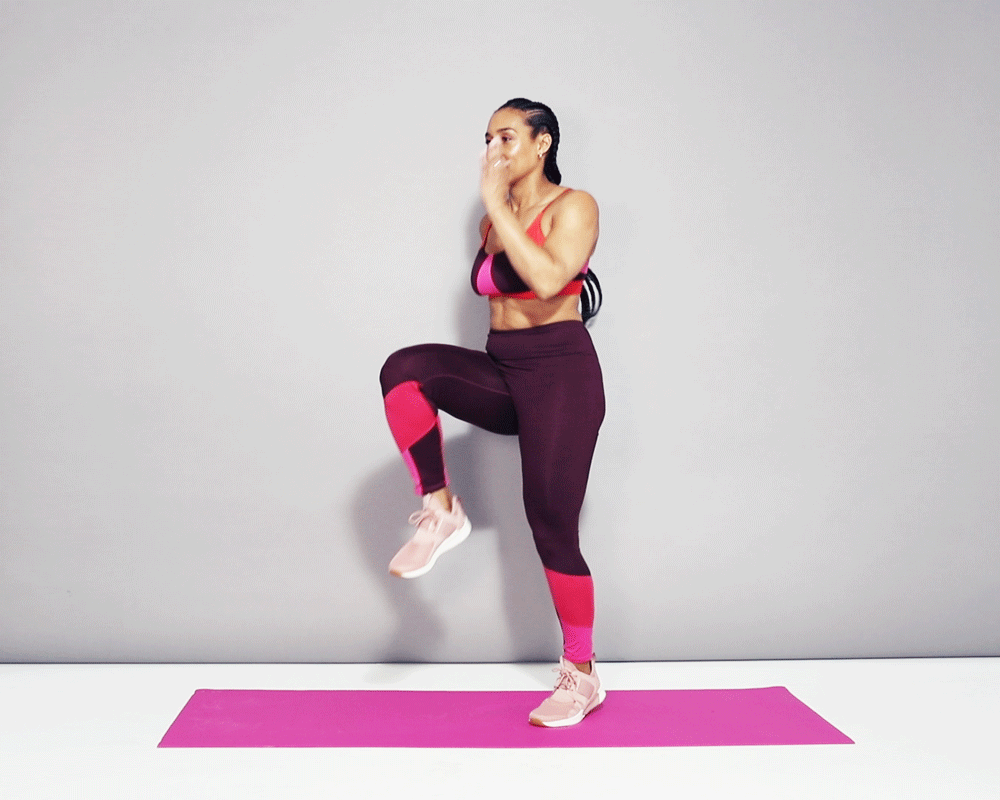
Try jogging in place for 15 to 30 seconds. Credit: Self magazine - Keep the heart healthy with cardio: Many astronauts say this is the toughest part of the workout: the stationary bike. It provides important cardiovascular exercise to improve circulation and keep the heart fit.
– Do six standing bicycle (or crisscross) crunches: Stand with legs hip-width apart, back straight, and knees slightly bent. Place your hands behind your head and brace your abs slightly. Lift your left knee as you rotate your right shoulder toward the knee (try to touch). Lower back to start and repeat on the other side.
– Seated adaptation: Try the reach across. Sitting comfortably, start with your left arm bent in an L by your side. Then, reach across your body and upward, extending your arm above your shoulder. Return to the starting position and repeat on the other side. Complete six repetitions. If you are able, you can also try this exercise with a twist at your waist to increase the stretch.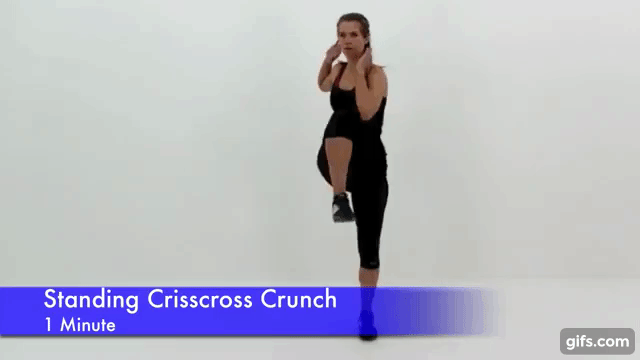
How many bicycle crunches can you do? Credit: Fitness Blender - Build muscle with weight training: On the ISS, astronauts use the ARED for weight training, increasing the resistance on the machine and the number of repetitions over time to counteract the effects of living in a zero-gravity environment. You may not have weights, but you do have something they don’t—gravity! Use your own body weight to exercise and keep vital muscle groups strong.
– Do 10 bicep curls: Stand with feet shoulder-width apart or sit comfortably in a chair. Relax your arms by your side, keeping your elbows close to your body. Contract your right and left biceps as you raise your hands toward your shoulders. Keep the movement slow and controlled. Lower your arms and repeat. (Note: Be sure to breathe with each movement of your arms.)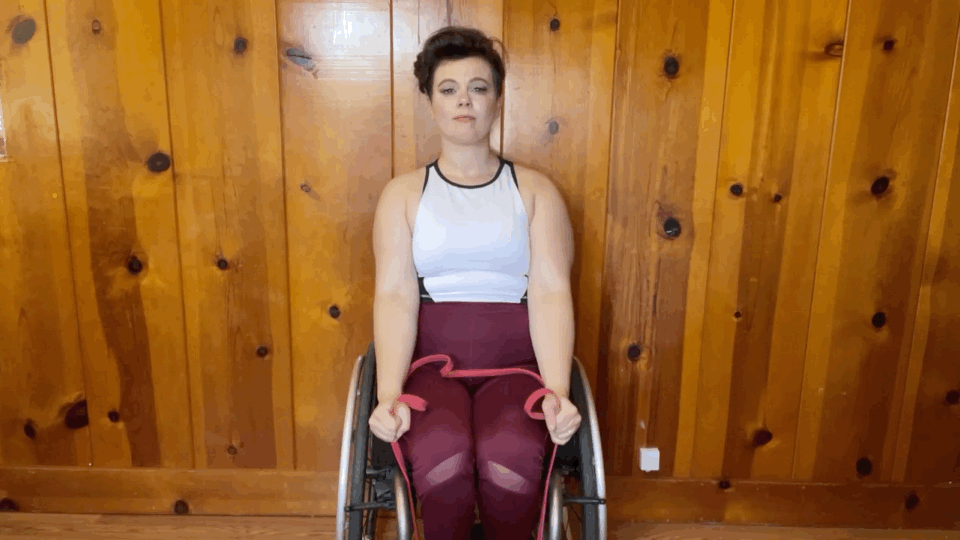
You can do bicep curls with your body weight, light weights, or resistance bands. Credit: Popsugar - Stretch it out: Take a moment to stretch out your body before you relax. It helps to soothe tight muscles, increase flexibility, and maintain the range of motion of the joints. Stretch your left arm straight out to the side. Gently fold your arm across your body as far as you can. Use your right hand to hold your arm close to your chest. Hold for five seconds. Repeat on the other side.
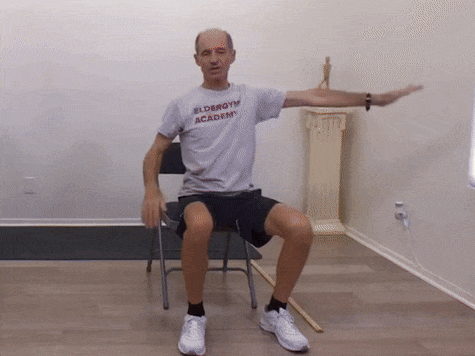
This is just one good stretch. What other stretches do you know? Credit: Eldergym Senior Fitness
Want a bigger challenge? Try the five-minute SciFri Exercise Like An Astronaut Workout below, or download more comprehensive instructions as a handy printable document.
The Most Unusual Laboratory (Not) on Earth
Why Do Astronauts Need To Exercise In Space?
On Earth, we’re constantly working against gravity. When we stand, walk, or lift things, our muscles and bones are battling Earth’s gravitational pull. This natural resistance keeps our bodies strong. But in space, it’s a whole different story!
On a space station, astronauts experience microgravity. They can float around and use their muscles with little effort. That may sound fun (and it is), but it can also harm an astronaut’s health. Without the stress of gravity, the body doesn’t maintain or build muscle and bone. So muscle weakens, and bones lose density. To counteract the effects of microgravity on the body, astronauts on the International Space Station exercise between two and two-and-a-half hours a day, six days a week. As they say, use it or lose it!
The heart may also weaken in space because it doesn’t have to counteract gravity to pump blood throughout the body. As a result, astronauts can experience changes similar to those caused by aging or illness. Meanwhile, blood and body fluids are pushed from the legs and abdomen to the heart and head, which causes swelling, leading to hearing loss, eye injury, and pressure on the brain.
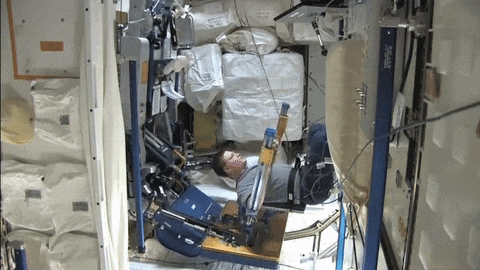
Exercise helps astronauts—and you—improve mental health as well. Physical activity reduces depression, anxiety, and stress. It also helps people sleep better, which positively affects mental health and regulates circadian rhythms, your body’s clock that controls when you feel alert or tired. Plus, exercise has been shown to improve memory and cognition.
So exercise in space isn’t just about staying fit. Astronauts need to maintain their mental health, heart health, muscle strength, and bone density. But here’s the exciting part: The research done on the ISS isn’t just helping astronauts. It helps people on Earth too!

What We Learn In Space Makes A Difference On Earth
Scientists are using information about bone and muscle loss in space to develop better treatments for common conditions like osteoporosis—a disease that causes bones to become weak and more likely to break—which affects over 10 million people over the age of 50 in the United States. Experiments on the ISS are helping researchers understand muscle loss from aging, injury, and muscle-wasting diseases. The European Space Agency is even planning an upcoming mission to the ISS for an astronaut with a prosthetic leg as they explore ways to make space travel more accessible. The exercise routines and equipment developed for astronauts to maintain their bones and muscles in microgravity can be adapted as therapies on Earth.
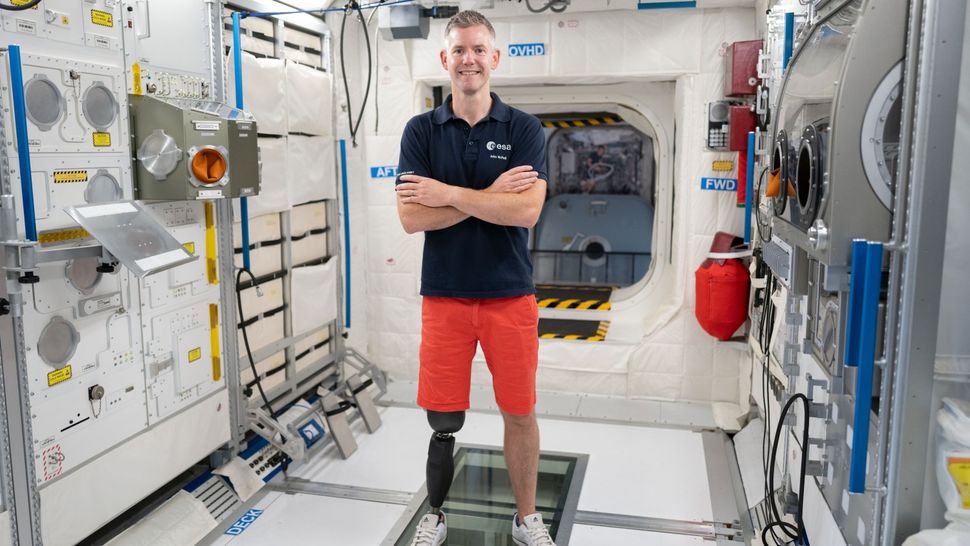
Climate change can make it hard or unsafe for people to exercise outdoors, especially older folks or those with breathing problems. As our planet gets warmer, some places have more heat waves, flooding, and air pollution. But again, the exercises and equipment for astronauts on the ISS are designed to be used in tight spaces, so they can be adapted for use indoors or in small spaces anywhere. Space research has also led to better ways of measuring lung health. A device first tested on astronauts is now used in hospitals to check for asthma and other breathing issues.
Even mental health research from space is useful. Astronauts deal with stress and isolation, just like some people may feel during extreme weather events. The same coping strategies developed for space—like getting regular physical activity—can help people on Earth deal with climate-related anxiety too.
To Get Ready For Mars, NASA Studies How The Body Changes In Space
Your Mission: Combat Health Challenges Caused By Climate Change
How can you use what you’ve learned about exercise in space to make life better here on Earth? Below are two ways science from the ISS could improve human health in areas affected by climate change. For each, imagine you’re a community health worker whose job is to promote good health and well-being in your area. Select which scenario you find more interesting, combine both ideas, or come up with your own way to help build better health through physical activity.
Design Challenges:
- Create a fun five-minute exercise routine that can be done inside when it’s too hot outside. Assume you will work out in a room that is 12 feet by 12 feet, with some common furniture in place. Use only things you can find around the house as equipment. Research safe exercise ideas and plan a routine to keep your muscles and heart strong. Then, make a short video of your routine or teach it to a friend or family member.
– What activities will you include in your routine?
– Why would you choose those activities?
– What health benefits would your routine provide? - Design a piece of exercise equipment using the machines on the ISS as inspiration, which can be used indoors by elderly community members when the air quality outside is low. It should be lightweight, mobile, and easy to store. You can only use recycled materials and common household items to build your equipment. Build a prototype of your equipment and demonstrate its use.
– What muscle group or body system is your equipment designed to strengthen?
– How will your equipment benefit the user?
– How could someone with a limited range of motion or a disability safely use it
Suggested materials:
- Design challenge worksheets
- Paper and pencils for planning and sketching
- Markers, pens, pencils
- A phone or computer to record a video (optional)
- Water bottles with caps (fill with water or sand to add weight)
- Cans of food (great as weights)
- Towels and blankets (as mats)
- Cardboard and cardboard tubes
- Rubber bands, elastic from old clothes, or bungee cords
- Wire, chenille stems, string, brads, paper clips or other connectors
- A small stool (optional, if you choose to include stepping activities)
- A sturdy chair (great for seated activities)
- Scissors
- Tape or glue
- Ruler or straight edge
When you’ve planned your solution, tested it a few times with different people, and adjusted it to best serve your goals, share it. Post your exercise routine or equipment prototype in the Down to Earth Community Lab so others can try it out. Share a photo, and we’ll include it HERE for everyone to see!
NOTES: Ask your adult before sharing your routine or prototype. Be sure to remove any identifying information. Before beginning any exercise routine, ensure you have a safe place to work out and consult a physician or other qualified medical professional with any questions you may have regarding a medical condition or treatment before undertaking a new health care regimen.
Want To Learn More?
There are many fun ways to continue exploring health and fitness in space and on Earth. Check out these ideas!
- Learn more about the T2 treadmill and the CEVIS stationary bicycle.
- Explore bone density and model osteoporosis with NASA’s Bag of Bones activity.
- Discover how your body develops muscle memory through physical activity and learn some ways to cope with stress with Science Friday’s Hack Your Brain activities!
- The United Nations has made good health and well-being one of its sustainable development goals. What are some ways you could support this goal in your community?
- There are many interesting ways to work in health sciences. Discover some of the exciting careers you could pursue.
NGSS Standards:
- MS-PS2-4: Motion and Stability: Forces and Interactions – Construct and present arguments using evidence to support the claim that gravitational interactions are attractive and depend on the masses of interacting objects.
- MS-LS1-5: From Molecules to Organisms: Structures and Processes – Construct a scientific explanation based on evidence for how environmental and genetic factors influence the growth of organisms.
- MS-ETS1-1: Engineering Design – Define the criteria and constraints of a design problem with sufficient precision to ensure a successful solution, taking into account relevant scientific principles and potential impacts on people and the natural environment that may limit possible solutions
- MS-ETS1-2: Engineering Design – Evaluate competing design solutions using a systematic process to determine how well they meet the criteria and constraints of the problem.
Career and Technical Education Career Clusters:
Health Science: This career cluster is focused on planning, managing, and providing therapeutic services, diagnostic services, health informatics, support services, and biotechnology research and development.
UN Sustainable Development Goals
Good Health and Well Being: Goal 3 aims to ensure healthy lives and promote well-being for all, at all ages.
Credits:
Lesson by Sandy Roberts
Copyediting by Erica Williams
Digital Production by Sandy Roberts

Special thanks to the ISS National Laboratory and the Center for Advancement of Science in Space™ (CASIS™) for funding this resource. Working together with NASA, the ISS National Lab aims to leverage the space station to inspire the next generation.
This resource is part of Science Friday’s Down To Earth: Space Science For Community Change program.
Educator's Toolbox
Meet the Writer
About Sandy Roberts
@KaleidoscopeSciSandy Roberts is Science Friday’s Education Program Manager, where she creates learning resources and experiences to advance STEM equity in all learning environments. Lately, she’s been playing with origami circuits and trying to perfect a gluten-free sourdough recipe.






